Researchers in Riyadh, Saudi Arabia have developed a new and more environmentally friendly chromatographic technique for the routine analysis of methylxanthines in commercial brands of tea.

Image Credit: Shulevskyy Volodymyr/Shutterstock.com
The technique rapidly detected the three most important methylxanthines, namely caffeine, theobromine, and theophylline, with good precision and reproducibility.
There is currently a lot of interest surrounding tea extract analysis, partly owing to tea being the most popular beverage in the world next to water and partly due to the increasing recognition that chromatographic analysis needs to be more ecofriendly.
Tea is both good and bad
Several studies have demonstrated the beneficial health effects of tea components such as phenols and vitamins, which may play a role in the prevention of various chronic diseases including arteriosclerosis and cardiovascular disease.
The methylxanthines found in tea exert several physiological effects including bronchial muscle relaxing and stimulation of the gastrointestinal, cardiovascular and respiratory symptoms and these substances have been used to treat various health conditions, including migraines and asthma.
However, excessive tea intake can also cause adverse effects such as insomnia, depression, and tachycardia and can negatively affect premenstrual syndrome and pregnancy. Researchers have reported that a fatal caffeine intake would be around 170 mg/kg of body weight.
The three main methylxanthines
The three main methylxanthines in tea are caffeine (1,3,7-trimethylxanthine), theobromine (3,7dimethylxanthine) and theophylline(1,3-dimethylxanthine), but their similar chemical structures makes them difficult to separate and analyze.
Several analytical methods have been developed including ion chromatography, capillary electrophoresis and high-performance liquid chromatography (HPLC), with the latter having been reported as the most frequently used.
For the current study, researchers developed and validated a new method for separating and determining the caffeine, theobromine and theophylline content using an ecofriendly mobile phase that was made up of 90% water and only 10% acetonitrile.
Comparing the method with all previously used ones
The team compared their new method - reversed-phase ultra-high-performance liquid chromatography coupled with MS detection (UHPLC-MS) - with all previous reports of methylxanthine analysis in plants, drugs, and other types of samples.
To the best of our knowledge, determination of caffeine, theobromine, and theophylline by UHPLC-MS has not been previously reported in the literature,”
Ahmad Aqel, Department of Chemistry at King Saud University, International Journal of Analytical Chemistry
Thirty commercially available tea samples of different brands were ground to fine powders and analyzed using a UHPLC-MS method that had been validated in terms of accuracy, sensitivity, specificity, and reproducibility.
What did the team find?
The team reports that the method proved to be, sensitive, effective and reproducible in the determination of all three compounds in all samples, which was rapidly achieved within just 30 seconds.
“Moreover, since the separation was achieved in isocratic elution mode with a mobile phase composed of 90% water and 10% acetonitrile, the proposed method can be considered as an inexpensive and environmentally friendly procedure,” write Aqel and team.
Caffeine and theobromine were detected in all tea samples and at maximum concentrations in one sample of 32.6 and 2.72mg/g, respectively. Theophylline, on the other hand, was detected in one sample at a concentration of (0.14mg/g) and found in trace amounts or not at all in other samples.
The new method was the fastest
When the authors compared their results with those of all previous studies investigating the same compounds using other techniques, they discovered that the method they had developed was the fastest, allowing high-throughput analyses at a rate of more than 100 samples per hour.
In this work, a new simple, sensitive, efficient, and green analytical method based on UHPLC-MS has been developed for a quick determination of methylxanthines including caffeine, theobromine, and theophylline in tea,”
“Both the quality parameters and the results obtained from this analysis method made the proposed UHPLC-MS method applicable for routine analysis of theobromine, theophylline, and caffeine with good precision and recovery,” concludes the team.
Journal reference:
Aqel A, et al. Rapid and Sensitive Determination of Methylxanthines in Commercial Brands of Tea Using Ultra-High-Performance Liquid Chromatography-Mass Spectrometry. International Journal of Analytical Chemistry Volume 2019, Article ID 2926580, 9 pages https://doi.org/10.1155/2019/2926580